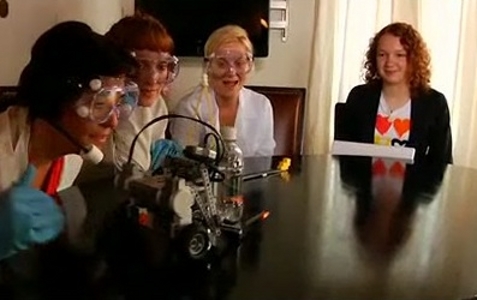Weekly Web Series Review: Smart Girls at the Party
Described by host Amy Poehler as “a celebration of real friendship, real fellowship, and a kind of community with other girls,” the web series “Smart Girls at the Party” is a kind-hearted, fun and educational program for kids and their parents alike, but especially for young girls. Often specifically focusing on girls who enjoy activities traditionally thought of as being more for boys, the series enjoyed a significant viewership boost in its first season when it introduced its youngest interviewee, seven-year-old Ruby, who speaks precociously about feminism. Its most-viewed episode to date features a 14-year-old boxer named Precela, and another highlight features a young robotics engineer named Rachel.
These are the “girls who are changing the world by being themselves,” in the words of Poehler, who hosts the show with the tongue-in-cheek seriousness of a news anchor before ending each episode with a dance party. Along with producer Meredith Walker and musical director Amy Miles, Poehler explores the special talents and interests of each girl – or in a few episodes, groups of girls – and interviews them, always ending on a “very serious question,” such as “pizza or cotton candy?” or “which is cuter, a baby panda or a baby monkey?” However, despite poking fun at self-serious interview questions, the series never makes fun of the girls or treats them or their interests with cynicism or irony. Instead, it clearly aims to imbue its young audience with a sense of self-worth and individuality, without being boring or preachy.
Now in its second season, the series has markedly improved from its first few episodes, adding a “World Famous 20 Second Song” segment for Miles and boasting higher production values. There are also some familiar faces in the dance parties that parents will enjoy spotting, including Poehler’s husband Will Arnett (who returns from the first season), as well as her “Parks and Recreation” co-stars Aziz Ansari, Nick Offerman, Rashida Jones and Aubrey Plaza. Look closely and you’ll also spot folks like Jon Hamm, David Cross and Jack McBrayer in later episodes. With its own new channel on YouTube, “Smart Girls at the Party” is slicker and more fun than ever, and is highly recommended for viewing with children, especially daughters, between the ages of five and fifteen.
You can follow us on Twitter and Facebook for content updates. Also, sign up for our email list for weekly updates and check us out on Google+ as well.
Posted in: Entertainment, Videos
Tags: Amy Miles, Amy Poehler, Aubrey Plaza, Aziz Ansari, boxer, celebrities, celebs, children's program, David Cross, educational program, Ezra Stead, female celebrities, female celebs, feminism, Jack McBrayer, Jon Hamm, Meredith Walker, Nick Offerman, Parks and Recreation, pizza, Rashida Jones, robotics, Smart Girls at the Party, web series, Weekly Web Series Review, Will Arnett, World Famous 20 Second Song, YouTube











